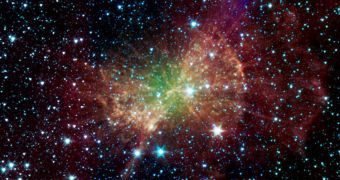Astronomers recently managed to capture a detailed view of the Dumbbell Nebula, a planetary nebula located about 1,360 light-years away, in the constellation Vulpecula. The object was seen in infrared wavelengths, which revealed details that were previously unknown.
For this research, experts used the NASA Spitzer Space Telescope, which is more than capable of piercing thick clouds of gas and dust in order to reach its targets. Astronomers say that structures is called the Dumbbell Nebula because it resembles a dumbbell when seen in visible light.
The object was first observed back in 1764, when it was included in Charles Messier's famous catalog of nebulous objects, as the 27th entry. Interestingly and unbeknown to the early astronomer, this was the first planetary nebula ever discovered.
This type of structures get their names from the fact that they resembled gas giants when viewed through early telescopes. Modern studies show that they most likely originate in Sun-sized stars.
As the cosmic fireballs reach the end of their burning cycle, the outer layers of their atmosphere expand, in a process that experts call “puffing out.” This gives planetary nebulae a fluffy appearance.
“These layers are heated by the hot core of the dead star, called a white dwarf, and shine with infrared and visible-light colors. Our own Sun will blossom into a planetary nebula when it dies in about five billion years,” Spitzer scientists explain in a statement.
They add that the Dumbbell Nebula, which is also known as Messier 27, spans about 4.5 light-years in diameter. This is larger than the distance between the Sun and its closest stellar neighbors, Alpha Centauri and Proxima Centauri.
“Spitzer's infrared view shows a different side of this recycled stellar material. It is interesting how different Spitzers view of the Dumbbell looks compared to optical images,” Harvard Smithsonian Center for Astrophysics (CfA) astronomer Dr. Joseph Hora says.
He believes that the green glow which permeates the image is being produced by hydrogen gas atoms being heated up by ultraviolet radiations released from the central white dwarf. This class of stars is characterized by the fact that its members burn helium rather than hydrogen.
“This image was made using data from Spitzer's Infrared Array Camera (IRAC). Blue shows infrared light with wavelengths of 3.6 microns, green represents 4.5-micron light and red, 8.0-micron light,” mission scientists conclude.

 14 DAY TRIAL //
14 DAY TRIAL //